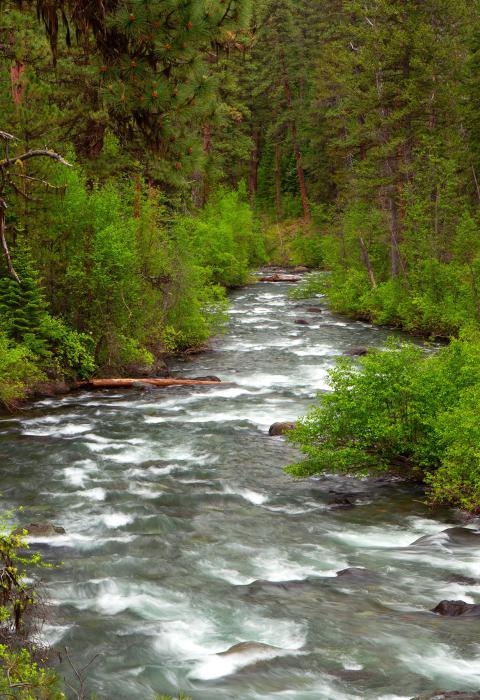Imnaha River
Oregon
The Imnaha River is located in northeast Oregon on the Wallowa-Whitman National Forest. Originating from the headwaters of the South Fork of the Imnaha River near Cusick Mountain in the Eagle Cap Wilderness, this 77-mile-long river flows through a mixture of Forest Service and private lands, eventually emptying into the Snake River. Its outstandingly remarkable values include recreation, scenery, fisheries, wildlife, historic/prehistoric, vegetation/botanical, and traditional value/lifestyles adaptation.
The river corridor supports unique plant communities and ecosystem diversity. Starting at 8,000 feet and descending to 950 feet, the river corridor contains most of the ecosystems found on the National Forest. Federally listed plants of interest include Wallowa primrose, fraternal paintbrush, Oregon oleander, MacFarlane's four o'clock, Geyer's onion, and Hazel's leptodactylon.
The Imnaha River Canyon exhibits the economic and social history of the region and the American West. The Nez Perce and later Euro-Americans adapted to its climatic and geographic conditions, and the traditional Western farm and ranch lifestyle is still active today.
Visitors can access the river in a variety of ways. The upper section in the Eagle Cap Wilderness is best accessed by trails from the Indian Crossing Trailhead. Forest Service and county roads provide access to most segments below the wilderness boundary. Camping along the river on National Forest Service lands is available at the Indian Crossing, Blackhorse, and Ollokot Campgrounds (fee sites).
Designated Reach
October 28, 1988. The main stem from the confluence of the North and South Forks of the Imnaha River to its mouth. The South Fork from its headwaters to the confluence with the main stem.
Outstandingly Remarkable Values
Botany
The river supports numerous proposed, endangered, threatened, and sensitive species of plants. These include, but are not limited to, Wallowa primrose, fraternal paintbrush, Oregon oleander, MacFarlan's four-o’clock, Geyer's onion, Hazel's leptodactylon.
Fish
Fisheries includes the populations and habitat of the threatened spring and fall Snake River chinook salmon and sensitive steelhead and bull trout.
History
This ORV includes the lifestyle that has evolved and is representative of the early Euro-American settlers within the Imnaha River corridor This lifestyle is dominated by a ranching/farming tradition that has evolved over time. This lifestyle, as it relates to the river, is an extension of how the river corridor has been used for centuries, including traditional uses by the Nez Perce Tribe.
Recreation
Although dispersed camping and developed camping at developed recreational sites are the dominant uses along the river, other activities are also popular. These include hunting, fishing, sightseeing, horseback riding, hiking, snowmobiling, picnicking, mushroom foraging, photography, and skiing, as well as other uses.
Scenery
Scenery along the river is dominated by a diverse landscape creating high-quality, natural scenery. The river traverses the climatic spectrum from glaciated mountains and alpine meadows, at over 8,000 feet in the Eagle Cap Wilderness, down to 100 feet elevation in rattlesnake and cactus country where it joins the Snake River. Human-made developments have a primitive, historic, or rustic western setting. The private lands are in a pastoral setting of historic and/or western culture.
Wildlife
Wildlife population in the corridor include Rocky Mountain bighorn sheep, mule deer, elk, and black bear. Proposed, endangered, threatened, and sensitive species of animals within the corridor include, but are not limited to, the Townsend's big-eared bat, peregrine falcon, and bald eagle.

